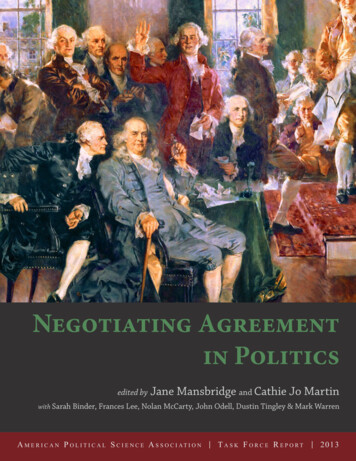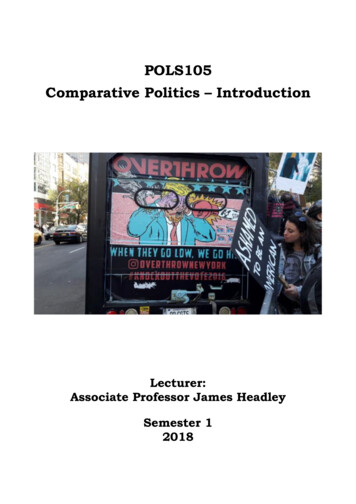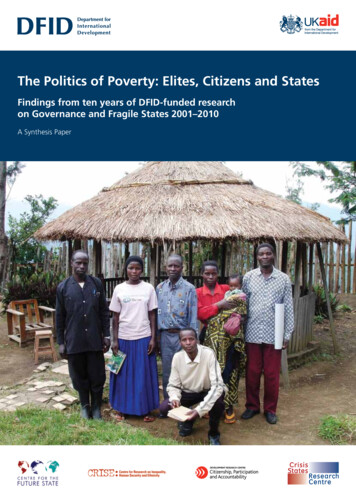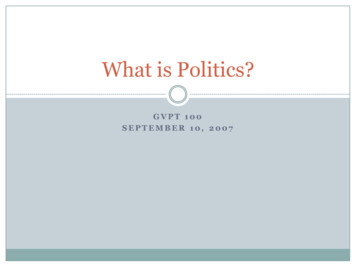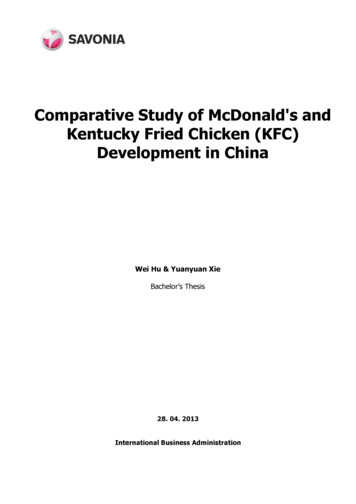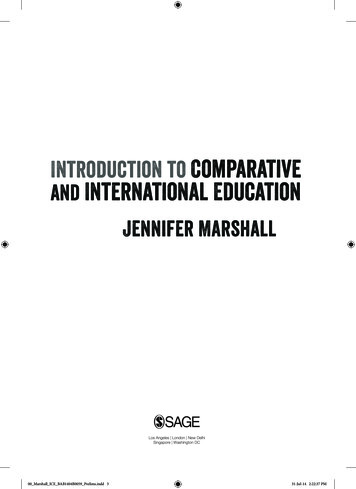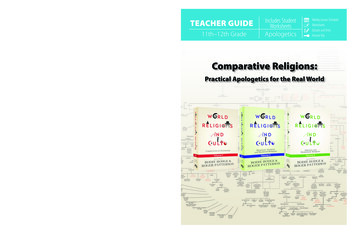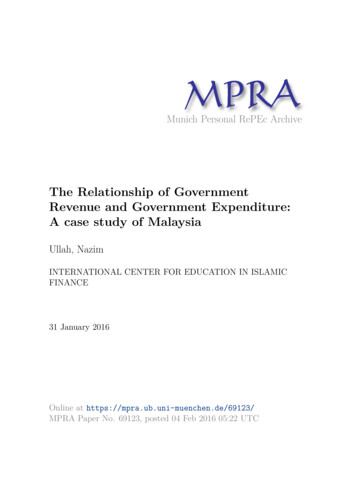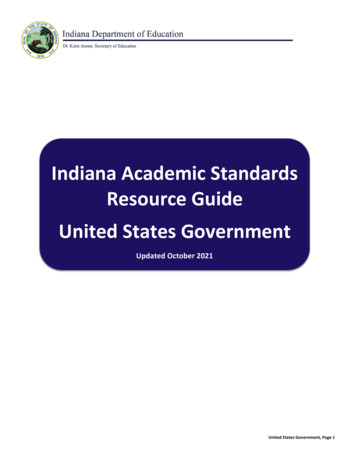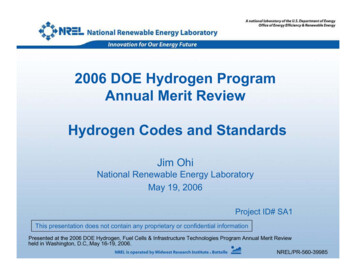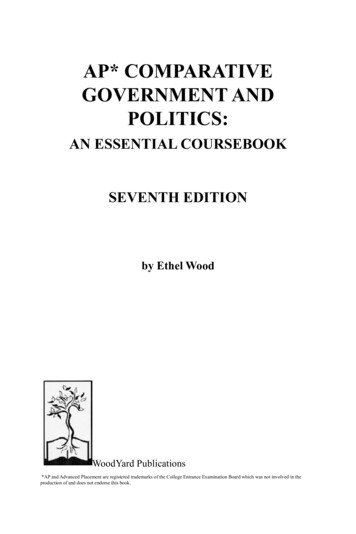
Transcription
AP* COMPARATIVEGOVERNMENT ANDPOLITICS:AN ESSENTIAL COURSEBOOKSEVENTH EDITIONby Ethel WoodWoodYard Publications*AP and Advanced Placement are registered trademarks of the College Entrance Examination Board which was not involved in theproduction of and does not endorse this book.
AP Comparative Government and Politics: An Essential Coursebook, Seventh EditionPublished byWoodYard Publications285 Main StreetGermantown, NY 12526Ph. 610-207-1366Fax dyardpublications.comTABLE OF CONTENTSPREFACE.7PART ONE: CONCEPTS.11Chapter One: Introduction to Comparative Government andPolitics: A Conceptual Approach.12Questions for Concepts for Comparison.82PART TWO: COUNTRY CASES.93Advanced Democracies.94Chapter Two: Government and Politics in Britain.99Questions for Britain.157Chapter Three: The European Union.167Questions for the European Union.187Communist and Post-Communist Regimes.191Chapter Four: Government and Politics in Russia.198Questions for Russia.259Chapter Five: Government and Politics in China.270All rights reserved. No part of this book may be reproduced or transmitted in anyform or by any means, electronic or mechanical, including photocopying, recording or by any information storage and retrieval system, without written permissionfrom the author, except for the inclusion of brief quotations in a review.Questions for China.329Copyright 2015 by Ethel WoodChapter Six: Government and Politics in Mexico.350ISBN 978-0-9895395-5-5Questions for Mexico.406Newly Industrializing and Less Developed Countries.340
Chapter Seven: Government and Politics in Iran.416Questions for Iran.472Chapter Eight: Government and Politics in Nigeria.482Questions for Nigeria.534PART THREE: SAMPLE EXAMINATIONS.545Sample Examination One.546Sample Examination Two.566MASTER CHARTS.584INDEX.588Why Comparative Government and Politics?I taught social studies classes for many years, mostly at Princeton HighSchool in Princeton, New Jersey. Like most social studies teachers,my experience included classes in United States history and government. I have also published review books, textbooks, readers, andweb materials that have required me to do extensive research in various types of American studies. Needless to say, I believe that an education in these areas is incredibly important for high school students,and every secondary curriculum should include them. So why is comparative government and politics particularly significant?The 21st century has taught us that we cannot ignore the world aroundus. Happenings around the globe now directly impact our lives, andsocial studies teachers and students around the country face the challenge of interpreting complex, puzzling events. The AP comparativecourse focuses on government and politics in other countries and provides a theoretical framework to compare political systems around theworld. It is my hope that this book will help students to grasp something of the political complexities of our global environment, and gainsome understanding of both commonalities and differences amongmodern political systems. In today’s world, we cannot afford not toknow.Ethel WoodGermantown, NYOctober 2015
Other Books by Ethel WoodPREFACE: THE COMPARATIVE GOVERNMENT ANDPOLITICS EXAMINATIONAmerican Government: A Complete CoursebookAP European History: An Essential Coursebook, 1st and 2nd editionsAP Human Geography: A Study Guide, 1st, 2nd, and 3rd editionsAP United States History: An Essential Coursebook, 1st and 2ndeditionsThe AP Comparative Government and Politics Examination administered by the College Board in May lasts for two hours and 25 minutesand consists of the following parts: 55 multiple-choice questions (45 minutes allowed; 50% ofAP grade) a 100-minute free response section consisting of 8 questions(50% of AP grade)AP World History: An Essential Coursebook, 1st and 2nd editionsThe Immigrants: An Historical ReaderIntroduction to SociologyMultiple Choice and Free-Response Questions in Preparation for theAP United States Government and Politics Examination, editions 1-7Multiple Choice and Free-Response Questions in Preparation for theAP World History Examination, editions 1 and 2Teacher’s Guide - AP Comparative Government and PoliticsThe Best Test Preparation for the Graduate Record Examination inPolitical ScienceThe multiple-choice questions cover all the topics listed below, andtest knowledge of comparative theory, methods, and government andpolitics in Britain, Russia, China, Mexico, Iran, and Nigeria. On theexam, the College Board no longer subtracts one-fourth of the number of questions answered incorrectly from the number of questionsanswered correctly to come up with your score. Since there is nopenalty for guessing, it is advisable to answer all questions the bestthat you can.The free-response questions are of three types: Definition and description (25% of free-response grade) –Students provide brief definitions or descriptions of five concepts or terms, briefly explaining their significance. Studentsmay have to provide an example of the definition or description in one or more of the six core countries. Conceptual analysis (one question; 25% of free-responsegrade) – Students must use major concepts from comparativepolitics, explain important relationships, or discuss the causesand implications of politics and policy. Country context (two questions; 50% of free-response grade;each question 25%) – These questions focus on specific countries, and require students to use core concepts to analyzeone country or compare two countries.The Presidency: An Historical Reader
The recommended total time for definition and description terms is 30minutes; for the conceptual analysis question, 30 minutes; and for eachof the two country context questions, 20 minutes. However, there areno time divisions among the free-response questions. Instead, a totalof 100 minutes is allotted to answer all of them.Generally, multiple-choice questions are distributed fairly evenlyamong the six countries. In addition, many questions are not countryspecific, but instead test knowledge of the major concepts. Accordingto the College Board, the topics of the multiple choice questions aredistributed as follows:Introduction (methods, purpose of comparisons).5%Sovereignty, Authority, and Power.20%Political Institutions.35%Citizens, Society, and State.15%Political and Economic Change.15%Public Policy.10%This newly revised 7th Edition of AP Comparative Government andPolitics: An Essential Coursebook is designed to help you prepare forthe exam by giving you a sound footing in comparative concepts aswell as country-specific information about the six core countries. Thebook is divided into three parts: Part One – Introduction to Comparative Government and Politics: A Conceptual Approach Part Two – Country Cases: Advanced Democracies (Great Britain), Communist and Post-Communist Regimes (Russia and China), and Less-Developed and Newly-Developing Countries (Mexico, Iran, and Nigeria) Part Three – Practice Examinations: Two complete practice exams, each with 55 multiple-choice questions and 8 free-responsequestionsYour best preparation for the exam is to know your stuff. The questions do require reading and writing skills, but the surer you are of thematerial, the more likely you are to answer the questions correctly.This book provides the concepts and information, as well as plentyof practice questions that will prepare you for the exam. The mostimportant things are that you learn something about comparative government and politics, and that you learn to love it, too!
10 CONCEPTS FOR COMPARISONCONCEPTS FOR COMPARISON 11PART ONE:CONCEPTS FOR COMPARISONS
12 CONCEPTS FOR COMPARISONCONCEPTS FOR COMPARISON 13 Analyzing and interpreting basic data for comparing politicalsystemsWHAT IS COMPARATIVE GOVERNMENT AND POLITICS?Comparative government and politics provides an introduction to thewide, diverse world of governments and political practices that existin modern times. Although the course focuses on specific countries,it also emphasizes an understanding of conceptual tools and methodsthat form a framework for comparing almost any governments thatexist today. Additionally, it requires students to go beyond individualpolitical systems to consider international forces that affect all peoplein the world, often in very different ways. Six countries form thecore of the course: Great Britain, Russia, China, Mexico, Iran, andNigeria. The countries are chosen to reflect regional variations, butmore importantly, to illustrate how important concepts operate bothsimilarly and differently in different types of political systems: “advanced” democracies, communist and post-communist countries, andnewly-industrialized and less-developed nations. This book includesreview materials for all six countries.Goals for the course include: Gaining an understanding of major comparative political concepts, themes, and trends Knowing important facts about government and politics inGreat Britain, Russia, China, Mexico, Iran, and Nigeria Identifying patterns of political processes and behavior andanalyzing their political and economic consequences Comparing and contrasting political institutions and processesacross countriesMost people understand that the term government is a reference tothe leadership and institutions that make policy decisions for a country. However, what exactly is politics? Politics is basically all aboutpower. Who has the power to make the decisions? How did powerholders get power? What challenges do leaders face from others –both inside and outside the country’s borders – in keeping power? So,as we look at different countries, we are not only concerned about theins and outs of how the government works; we will also look at howpower is gained, managed, challenged, and maintained.College-level courses in comparative government and politics vary instyle and organization, but they all cover topics that enable meaningful comparisons across countries. These topics are introduced in thepages that follow, and will be addressed in greater depth when each ofthe countries is covered separately.The topics are: The Comparative Method Sovereignty, Authority, and Power Political and Economic Change Citizens, Society, and the State Political Institutions Public PolicyTOPIC ONE: THE COMPARATIVE METHODPolitical scientists sometimes argue about exactly what countriesshould be studied and how they should be compared. One approachis to emphasize empirical data based on factual statements and statistics, and another is to focus on normative issues that require valuejudgments. For example, the first approach might compare statistics
14 CONCEPTS FOR COMPARISONCONCEPTS FOR COMPARISON 15that reflect economic development of a group of countries, including information about Gross National Product, per capita income, andamounts of imports and exports. The second approach builds on thosefacts to focus instead on whether or not the statistics bode well or illfor the countries. Empiricists might claim that it is not the role of political scientists to make such judgments, and their critics would replythat the empirical approach alone leads to meaningless data collection.The approaches give us different but equally important tools for analyzing and comparing political systems.As with research in any social science, comparative government andpolitics relies on scientific methods to objectively and logically evaluate data. After reviewing earlier research, researchers formulate a hypothesis, a speculative statement about the relationship between twoor more factors known as variables. Variables are measurable traitsor characteristics that change under different conditions. For example,the poverty level in a country may change over time. One questionthat a comparative researcher might ask is, “Why are poverty rateshigher in one country than in others?” In seeking to answer this question, the researcher want to identify which variable or variables maycontribute to high levels of poverty. In other words, the researcheris trying to discover causation – the idea that one (or more) variablecauses or influences another. So a credible hypothesis might be thathigher poverty levels are caused by lower levels of formal education.In this hypothesis, one variable (the poverty level) is called the dependent variable because it is caused or influenced by another variable(the level of formal education), which is called the independent variable. A correlation exists when a change in one variable coincideswith a change in the other. Correlations are an indication that causality may be present; they do not necessarily indicate causation. Comparative researchers seek to identify the causal link between variablesby collecting and analyzing data.How do we go about comparing countries? The model most frequently used until the early 1990s was the three-world approach,largely based on cold war politics. The three worlds were 1) theUnited States and its allies; 2) the Soviet Union and its allies; and 3)“third world” nations that did not fit into the first two categories andwere economically underdeveloped and deprived. Even though theSoviet Union collapsed in 1991, this approach is still taken today by many comparative textbooks, whose comparisons are basedon democracy vs. authoritarianism and communism vs. capitalism. Even though this method is still valid, newer types of comparisons between countries are reflected in the following three trends: The impact of informal politics – Governments have formalpositions and structures that may be seen on an organizationalchart, but these formal elements are not all that there is to political systems. For example, in formal terms Great Britainis led by a prime minister and has a House of Lords and aHouse of Commons. In comparison, the United States has apresident, a Senate, and a House of Representatives. You maydirectly compare the responsibilities and typical activities ofeach position or structure in Britain to its counterpart in theUnited States. However, you gain a deeper understanding ofboth political systems if you connect civil society – the waythat citizens organize and define themselves and their interests– to the ways that the formal government operates. Informalpolitics takes into consideration not only the ways that politi-
16 CONCEPTS FOR COMPARISONcians operate outside their formal powers, but also the impactthat beliefs, values, and actions of ordinary citizens have onpolicy-making. The importance of political change – One reason that thethree-world approach has become more problematic in recentyears is that the nature of world politics has changed. Since1991, the world no longer has been dominated by two superpowers, and that fact has had consequences that have reverberated in many areas that no one could have predicted. However,it creates an opportunity to compare the impact of change onmany different countries. The integration of political and economic systems – Eventhough we may theoretically separate government and politicsfrom the economy, the two are often intertwined almost inextricably. For example, communism and capitalism are theoretically economic systems, but how do you truly separate themfrom government and politics? Attitudes and behavior of citizens are affected in many ways by economic inefficiency, economic inequality, and economic decision making. If citizensturn to the government for solutions to economic problems andgovernment does not respond, they may revolt, or take otheractions that demand attention from the political elite.Keeping these trends in mind, in this book we will study countries inthree different groups that are in some ways similar in their politicaland economic institutions and practices. These groups are: “Advanced” democracies – These countries have well established democratic governments and a high level of economicdevelopment. Of the six core countries that we study in thiscourse, Great Britain represents this group. Communist and post-communist countries – These countries have sought to create a system that limits individual freedoms in order to divide wealth more equally. Communismflourished during the 20th century, but lost ground to democratic regimes by the beginning of the 21st century. Russia (asa post-communist country) and China (currently a communistCONCEPTS FOR COMPARISON 17country) represent this group in our study of comparative government and politics. Less-developed and newly-industrializing countries – Wewill divide the countries traditionally referred to as the “ThirdWorld” into two groups, still very diverse within the categories. The newly-industrializing countries are experiencing rapid economic growth, and also have shown a tendency towarddemocratization and political and social stability. Mexico andIran represent this group, although, as you will see, Iran hasmany characteristics that make it difficult to categorize as oneor the other. Less-developed countries lack significant economic development, and they also tend to have authoritariangovernments. Nigeria represents this group, although it hasshown some signs of democratization in very recent years.Important concepts that enable meaningful comparisons among countries are introduced in this chapter, and will be addressed with eachof the individual countries separately. However, it is important to remember that the main point of comparative government and politics isto use the categories to compare among countries. For example, nevertake the approach of “Here’s Britain,” “Here’s Russia,” without notingwhat similarities and differences exist between the two countries.TOPIC TWO: SOVEREIGNTY, AUTHORITY, AND POWERWe commonly speak about powerful individuals, but in today’s world,power is territorially organized into states, or countries, that controlwhat happens within their borders. What exactly is a state? Germanscholar Max Weber defined state as the organization that maintainsa monopoly of violence over a territory. In other words, the statedefines who can and cannot use weapons and force, and it sets therules as to how violence is used. States often sponsor armies, navies,and/or air forces that legitimately use power and sometimes violence,but individual citizens are very restricted in their use of force. Statesalso include institutions: stable, long-lasting organizations that helpto turn political ideas into policy. Common examples of institutionsare bureaucracies, legislatures, judicial systems, and political parties.These institutions make states themselves long-lasting, and often help
18 CONCEPTS FOR COMPARISONCONCEPTS FOR COMPARISON 19transportation, and effective communication systems – and economicstability. The concept of state is closely related to a nation, a group ofpeople bound together by a common political identity. Nationalism isthe sense of belonging and identity that distinguishes one nation fromanother. Nationalism is often translated as patriotism, or the resultingpride and loyalty that individuals feel toward their nations. For morethan 200 years now, national borders ideally have been drawn alongthe lines of group identity. For example, people within one area thinkof themselves as “French,” and people in another area think of themselves as “English.” Even though individual differences exist withinnations, the nation has provided the overriding identity for most ofits citizens. However, the concept has always been problematic – aswhen “Armenians” live inside the borders of a country called “Azerbaijan.” Especially now that globalization and fragmentation providecounter trends, the nature of nationalism and its impact on policymaking are clearly changing.Variations of the Nation Statethem to endure even when leaders change. By their very nature, statesexercise sovereignty, the ability to carry out actions or policies withintheir borders independently from interference either from the inside orthe outside.A state that is unable to exercise sovereignty lacks autonomy, and because it is not independent, it may be exploited by leaders and/or organizations that see the state as a resource to use for their own ends.Frequently, the result is a high level of corruption. The problem isparticularly prevalent in newly-industrializing and less-developedcountries, largely because their governments lack autonomy. For example, military rulers in Nigeria stole vast amounts of money fromthe state during the 1990s, making it one of the most corrupt countriesin the world. Today Nigeria’s tremendous revenues from oil largelyevaporate before they reach ordinary citizens, providing evidence thatcorruption is still a major issue in Nigeria.States, Nations, and RegimesStates do much more than keep order in society. Many have important institutions that promote general welfare – such as health, safeA binational or multinational state is one that contains more thanone nation. The former Soviet Union is a good example of a multinational state. It was divided into fifteen “soviet republics” that werebased on nationality, such as the Ukraine, Kazakhstan, Estonia, Latvia, and Lithuania. When the country fell apart in 1991, it fell alongethnic boundaries into independent nation-states. Today Russia (oneof the former soviet republics) remains in itself a large multinationalstate that governs many ethnic groups. Just as ethnic pressures challenged the sovereignty of the Soviet government, the Russian government has faced “breakaway movements” – such as in Chechnya – thathave threatened Russian stability. Minority ethnic groups may feel sostrongly about their separate identities that they demand their independence. Stateless nations are a people without a state. In the MiddleEast the Kurds are a nation of some 20 million people divided amongsix states and dominant in none. Kurdish nationalism has survivedover the centuries, and has played an important role in the politics thatfollowed the reconfiguration of Iraq after the Iraqi War that began in2003.
20 CONCEPTS FOR COMPARISONCONCEPTS FOR COMPARISON 21its northeastern coastline from Washington D.C. to Boston. A secondary core area exists on the West Coast that runs from San Diego in thesouth to San Francisco in the north. Arguably, other core areas havedeveloped around Chicago and other Midwestern cities, and Atlanta inthe South. Despite the multiple core areas, regional differences do notthreaten the existence of the state, as they do in Nigeria.A Stateless Nation. The Kurds have had a national identity for many centuries,but they have never had a state. Instead, 20 million Kurds are spread in an areathat crosses the formal borders of six countries: Turkey, Syria, Iraq, Iran, Armenia,and Azerbaijan.Core AreasMost of the early nation-states grew over time from core areas, expanding outward along their frontiers. Their growth generally stoppedwhen they bumped up against other nation-states, causing them to define boundaries. Today most European countries still have roughly thesame core areas as long ago, and many countries in other parts of theworld also have well-defined core areas. They may be identified ona map by examining population distributions and transport networks.As you travel away from the core area, into the state’s periphery (outlying areas), towns get smaller, factories fewer, and open land morecommon. Clear examples of core areas are the Paris Basin in Franceand Japan’s Kanto Plain, centered on the city of Tokyo. States withmore than one core area – multicore states – may be problematic,especially if the areas are ethnically diverse, such as in Nigeria. Nigeria’s northern core is primarily Muslim and its southern core is Christian, and the areas pull the country in different directions. To compensate for this tendency for the country to separate, the capital city wasmoved from Lagos (in the South) to Abuja, near the geographic centerof the state.A multicore character is not always problematic for a country. Forexample, the United States still has a primary core area that runs alongThe rules that a state sets and follows in exerting its power are referredto collectively as a regime. Regimes endure beyond individual governments and leaders. We refer to a regime when a country’s institutions and practices carry over across time, even though leaders andparticular issues change. Regimes may be compared by using thesetwo categories: democracies and authoritarian systems.DemocraciesThis type of regime bases its authority on the will of the people. Democracies may be indirect, with elected officials representing thepeople, or they may be direct, when individuals have immediate sayover many decisions that the government makes. Most democraciesare indirect, mainly because large populations make it almost impossible for individuals to have a great deal of direct influence on how theyare governed. Democratic governments typically have three majorbranches: executives, legislatures, and judicial courts. Some democracies are parliamentary systems – where citizens vote for legislativerepresentatives, who in turn select the leaders of the executive branch.Others are presidential systems – where citizens vote for legislativerepresentatives as well as for executive branch leaders, and the twobranches function with separation of powers. Democratic governments vary in the degree to which they regulate/control the economy, but businesses, corporations, and/or companies generally operatesomewhat independently from the government. Parliamentary systems – In this type of democracy, the principle of parliamentary sovereignty governs the decisionmaking process. Theoretically, the legislature makes the laws,controls finances, appoints and dismisses the prime ministerand the cabinet (the other ministers), and debates public issues.In reality, however, strong party discipline within the legisla-
22 CONCEPTS FOR COMPARISONCONCEPTS FOR COMPARISON 23ture develops over time, so that the cabinet initiates legislationand makes policy. The majority party in the legislature almost always votes for the bills proposed by its leadership (theprime minister and cabinet members). Even though the opposition party or parties are given time to criticize, the legislatureeventually supports decisions made by the executive branch.Because the prime minister and cabinet are also the leadersof the majority party in the legislature, no separation of powers exists between the executive and legislative branches. Instead, the two branches are fused together. Also typical of theparliamentary system is a separation in the executive branchbetween a head of state (a role that symbolizes the power andnature of the regime) and a head of government (a role thatdeals with the everyday tasks of running the government). Forexample, in Great Britain, the queen is the head of state whoseldom formulates and executes policy, and the prime ministeris the head of government who directs the country’s decisionmaking process in his or her position as leader of the majorityparty in parliament. Presidential systems – In this type of democracy, the roles ofhead of state and head of government are given to one person– the president. This central figure is directly elected by thepeople and serves as the chief executive within a system ofchecks and balances between the legislative and executive(and sometimes judicial) branches. The separation of powers between branches ensures that they share power and thatone branch does not come to dominate the others. As a result,power is diffused and the policymaking process is sometimesslowed down because one branch may question decisions thatanother branch makes. In order for presidential systems totruly diffuse power, each branch must have an independentbase of authority recognized and respected by politicians andthe public. The United States is a presidential system, as areNigeria and Mexico. As we will see, an important question iswhether or not the branches have truly independent bases ofauthority in Mexico and Nigeria.Some countries combine elements of the presidential and parliamentary systems, as is illustrated in Russia’s 1993 Constitution. Al
POLITICS EXAMINATION The AP Comparative Government and Politics Examination adminis - tered by the College Board in May lasts for two hours and 25 minutes and consists of the following parts: 55 multiple-choice questions (45 minutes allowed; 50% of AP grade) a 100-minute free res
